Story by Marc Milner
Photography by Stephen J. Thorne
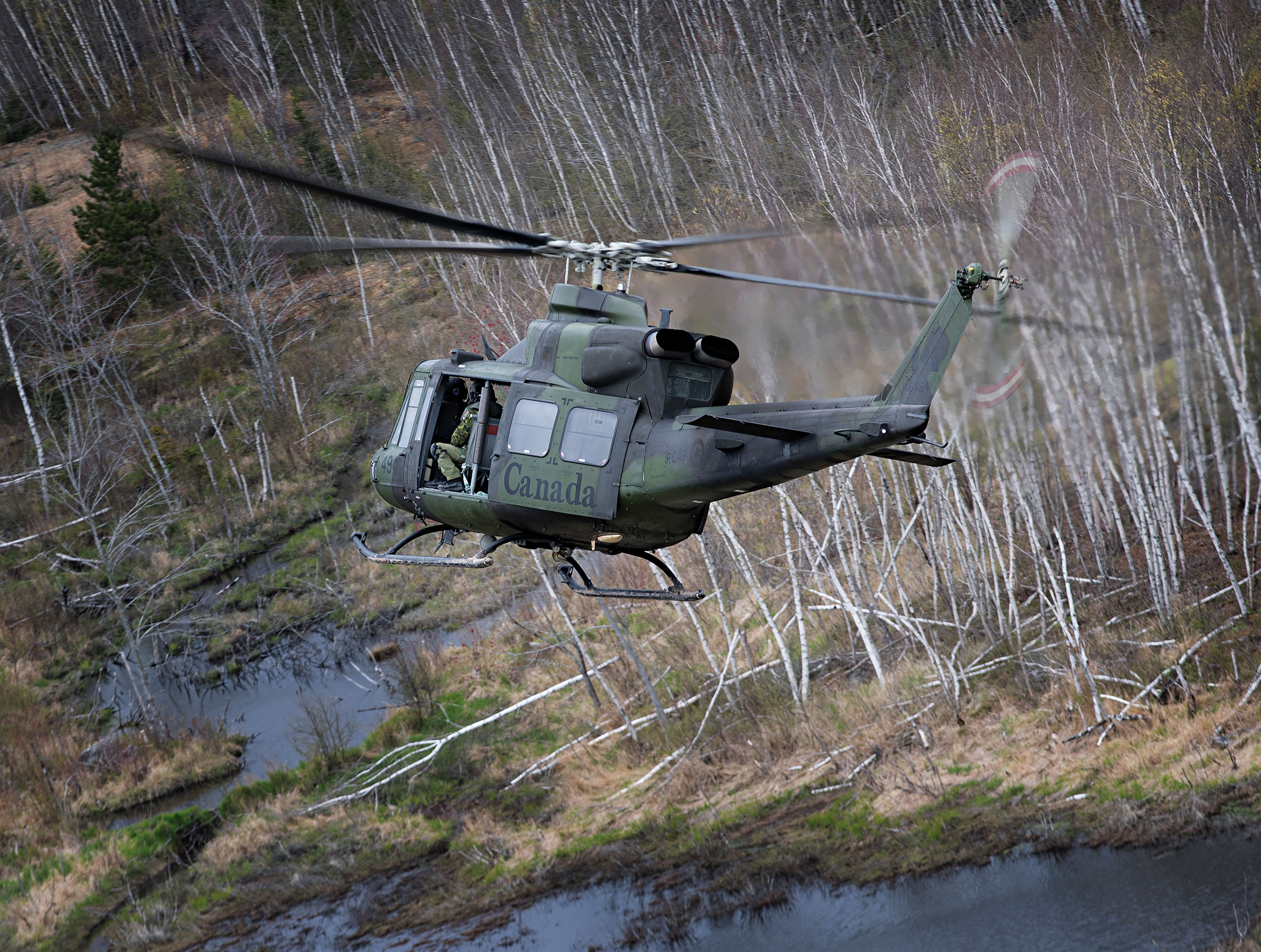

The word comes in late in the evening: the president and the provisional government of “West Isles” are surrounded by a rebel force in the capital city of “Blue Mountain.” They need to be saved from the rebels if the peace-support mission in the region is to succeed. Canadian Special Operations Forces have them protected in a secure compound—and it’s time to send in the Griffons.
“The Griffons are enablers,” said Captain Nate Fenn, an instructor with 403 Squadron in New Brunswick, where aircrew train to fly the Royal Canadian Air Force’s fleet of Bell CH-146 Griffon helicopters. “Success is measured by how things go for the guy on the ground. If a corporal fails in his task because we did not do our job, that’s mission failure.”
The Griffons make up the largest fleet operated by the RCAF, with some 85 in service. They provide a fast, versatile response during military operations and civil emergencies, including terrorist incidents, humanitarian crises, UN missions, floods and fires, search and rescue, and a myriad of other tasks. In short, the Griffon is Canada’s utility helicopter.
The bulk of Canada’s Griffons belong to the RCAF’s 1 Wing, whose job is to support the army. Based in Borden, Ont., 400 Squadron handles maintenance; 430 flies out of CFB Valcartier in Quebec.; 408 is based in Edmonton; 438 calls Montreal home; 403, the Helicopter Operational Training Squadron, is in Gagetown, N.B. Griffons are also flown by 427 Special Operations Aviation Squadron in Petawawa, Ont., along with Chinooks from 450 Tactical Helicopter Squadron, also based at CFB Petawawa.


Helicopters from 1 Wing provided essential cover and support for Canada’s mission in Kandahar, Afghanistan, in 2009-11. The RCAF deployed six CH-147D Chinooks—acquired from the United States in 2008—and eight Griffons to escort them, mainly on resupply and route surveillance missions. One of those Griffons crashed during takeoff in dusty conditions on July 6, 2009, and two Canadian and one British servicemen lost their lives. Some of Canada’s seven newer CH-147Fs—again escorted by Griffons—flew casualty-evacuation missions in Mali in 2018-19.
By tactical helicopter standards, the Griffon is pretty plain. It is, in fact, a Bell 412, which is commonly used in the oil industry, by police forces and by militaries. No big weapon pods dangle from stubby wings, and no bulky sensors mar the sleek outside of the airframe.
Some have criticized the aircraft for being underpowered, particularly when armour plating is installed, but the Griffon does have a bite. Machine guns can be mounted in the doors. In a hot operational environment, it is not unusual for a Griffon to have a C6 machine gun on one side and a .50-calibre machine gun on the other. The .50 calibre has a long reach and is very accurate. “Like a laser,” said Flight Sergeant Adam Vandenberg.
In addition, the very effective M134 Minigun—a Gatling gun capable of up to 6,000 rounds a minute—can be door-mounted or slung from beneath. As many hostile forces have discovered, messing with an operational CH-146 can produce a very nasty surprise.
Like most weapons in the Canadian Armed Forces, the secret of the Griffons’ success is the people who operate them. That starts at the basic helicopter course in Portage, Man., where new rotary-wing pilots learn to fly the Bell Jet Ranger. But that does not teach them how to fly a tactical helicopter in support of the army. That job belongs to 403 Squadron at CFB Gagetown and its Tactical First Officer training course.
Griffon pilots have to develop “good hands and feet” for tactical flying, said Capt. Jason McLinton of 403’s safety and standards flight. And they have to be able to fly fast and low, day or night. Becoming one with the machine is essential when you’re brushing treetops at 170 kilometres per hour. Other skills include flying in dispersed formation (not following directly behind another helicopter), using valleys, hills, streams and ridgelines as cover, and arriving prepared to battle an alert enemy with weapons pointing skyward.
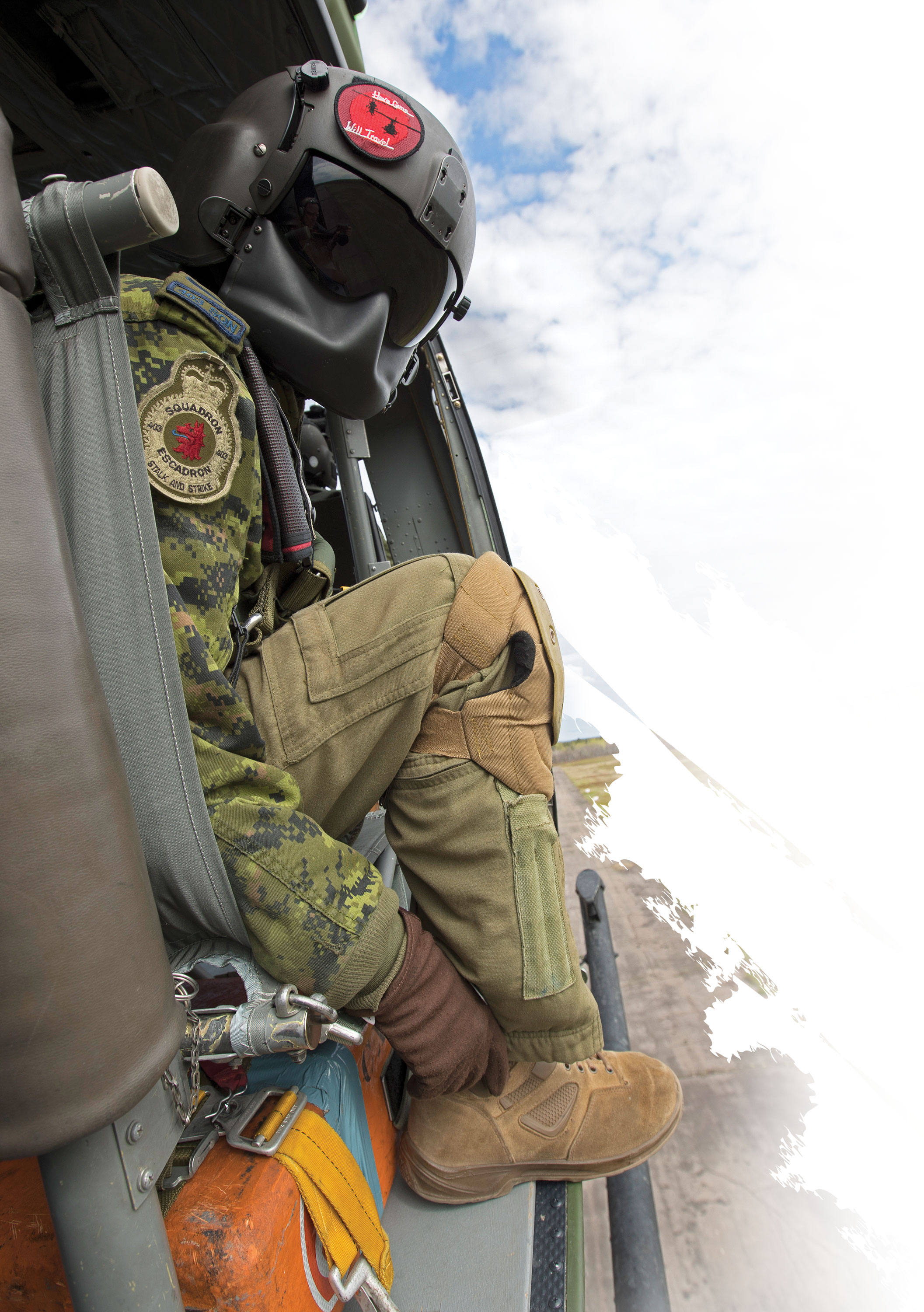

Another challenge is flying in arid, almost-treeless conditions such as in Afghanistan and Mali. Landing in a dust ball cannot be learned in Canada, although landing in snow is a good simulation. Afghanistan pilots trained in Arizona; pilots in Mali learned on the job. Any way you slice it, tactical helicopter flying is not for the faint of heart.
Behind the pilot and co-pilot is the third member of a Griffon’s crew. The flight engineer runs the show in the back of the helicopter, managing loads, manning weapons, and scanning the ground and surrounding areas. When things get hot, the flight engineer fires the door gun to deal with the threat. A flight engineer’s training is actually harder than a pilot’s. Candidates must already have four to six years of experience as maintainers. They know the Griffon inside out before they become aircrew.
Landing a Griffon in a clearing not much bigger than its rotor size and airframe length requires close attention to height, drift and distance between rotor tips and trees. Flight engineers track all that, feeding the pilots a steady stream of information: “Move right ten.” “Stop.” “Back up five, four, three, two, one. Stop.” “Ten feet off the ground; five, three, one, skids on the ground.” And on it goes.
Unlike the free-for-all flying depicted in Hollywood movies, hitting time targets is an essential component of effective tactical flying. Crew members must have “a critical appreciation of timings,” as squadron commander Lieutenant-Colonel Jim Knutsson put it, to manage fuel and load against time and distance.
Helicopters landing too slowly may delay those coming in next. Arriving too early at a landing zone may alert the enemy; too late and those on the ground waiting for extraction may be at greater risk.
Anything that makes an aircraft vulnerable—such as trailing in the wash behind another helicopter—must be avoided. Pilots need to fly their own aircraft, keep a safe formation distance from others (measured in rotor length), and meet critical timings.
Equipment emergencies and dangerous tactical scenarios are integrated into the training. “Everything is a bombardment of emergencies!” said Vandenberg. More extreme situations—engine or rotor failures, for example—are practised in 403’s simulator. But every student’s training includes potentially disastrous scenarios in the air that they must master smoothly. Their instructors must have nerves of steel. Few pilots or flight engineers fail the course, but they don’t get an easy pass.
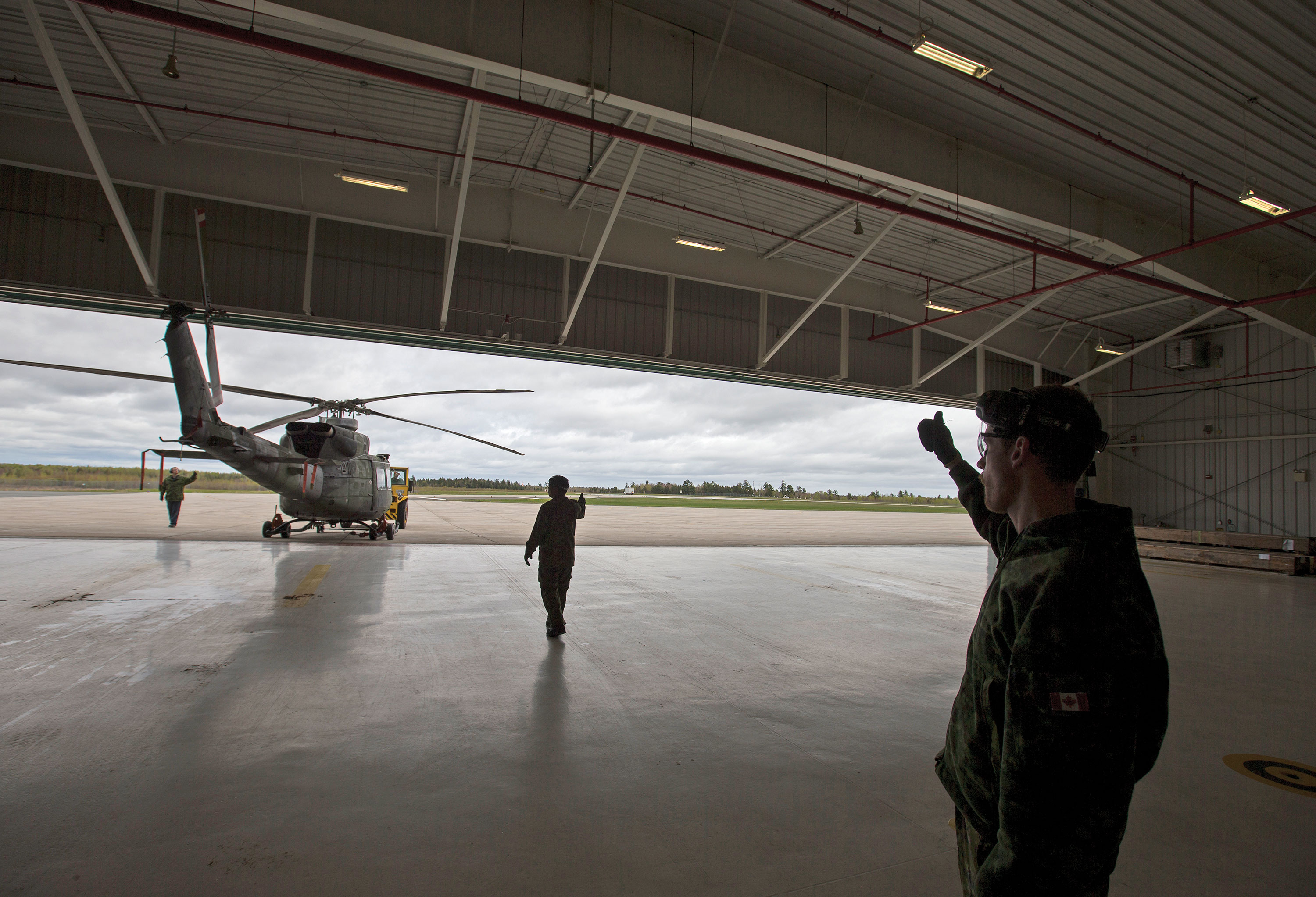
The mission to extract the president of West Isles will be conducted in three distinct phases:
Phase one is a high transit to “Milsom Hill” for the aircraft rendezvous, followed by a low approach (using the topography to mask movement) to holding area “Quebec,” just short of the extraction point.
Phase two is the extraction itself—the most dangerous part. Two helicopters will land while the mission commander flies cover. If the Griffons take fire on the final approach to the landing zone, the mission commander must decide whether to carry on or abort.
Phase three is the exfiltration to forward operating base “Petersville.” That should take about 12 minutes.
All three choppers on the mission are carrying door guns. The mission commander has studied meteorology forecasts, route maps, communications plans, tactical scenarios, aircraft status and enemy threat assessments. The main threat is improvised explosive devices.
IEDs are a threat not normally associated with helicopters, but they affect the choice of emergency landing spots. Sometimes an aircrew will keep flying rather than land on what appears to the untrained eye as a nice clear stretch of road. And pilots crossing power lines will fly between the poles, not over them—Claymore mines on top of power poles can be remotely detonated or triggered by low-flying helicopters. Small arms fire is also a constant danger.
The Griffons assigned to rescue the president of West Isles will each carry 820 kilograms of fuel. (The choppers consume anywhere from 90 to 330 kilograms of fuel an hour, depending on the mission and the load.) This mission requires about 400.
The weather is good, with a high ceiling, a light northwest wind and excellent visibility. After the briefing, crews have about an hour to complete a final check of the flight plan, communications and equipment.
As the aircrew go through their final checks in the hanger, the Griffons sit, ready to go, on the tarmac.
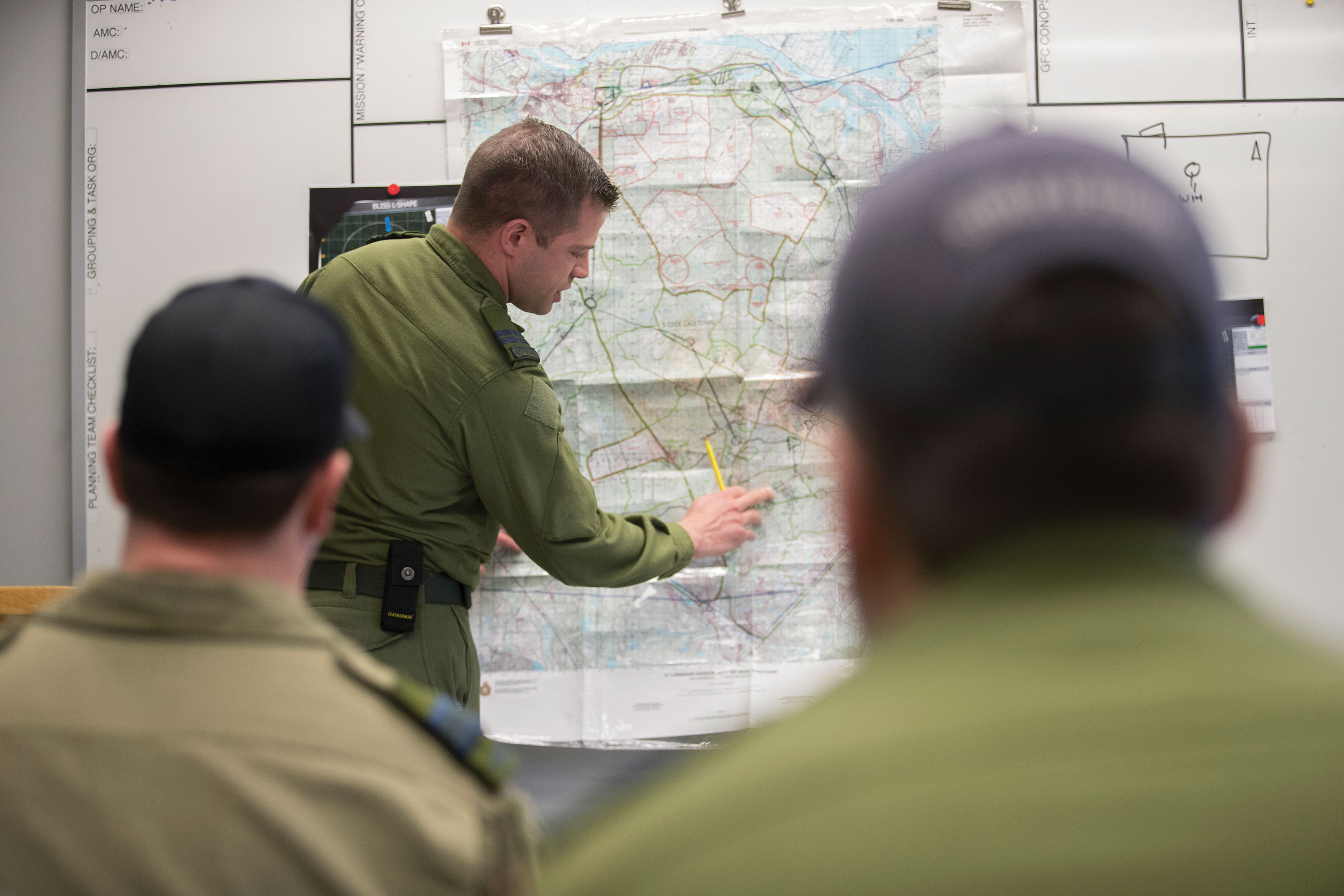

Like all helicopters, the 5.4-tonne Griffon is a complex machine. Its twin Pratt & Whitney PT6T-3D gas turbine engines generate 1,800 horsepower on liftoff. The bulk of that power moves from the engines through a complex gearbox to the mast, into a complex rotor head and out to four 6.7-metre blades. The rest goes aft, through the boom, to the small tail rotor. Unlike conventional aircraft, the strain on helicopter powertrains and airframes is enormous. It all has to purr smoothly or the Griffon can’t fly.
Many of a Griffon squadron’s personnel, not surprisingly, are maintainers who handle almost everything themselves, short of the mandatory 600-hour check. On overseas tours, a majority of the maintenance personnel deploy as well, and they don’t travel light.
Forty-four people, organized into three crews, work on 403’s helicopters, most in two shifts between 7:30 a.m. and 11 p.m. A small cadre works into the wee hours, tackling snags arising from the day’s flying. Forty maintainers, working day and night, seven days a week, kept eight Griffons flying in Afghanistan. “It’s work, sleep and repeat, until the tour is over,” said Chief Warrant Officer Jacques Friolet.
Griffon squadrons have everything they need to keep the aircraft flying. They can cut, bend, shape and rivet any part of the airframe, using plasma cutters, lathes, casting machines and bending presses on material from aluminum to titanium. Thousands of tools of every shape and size, many highly specialized for specific jobs on the Griffon, are on hand.
Seventy tool boards and four large tool boxes line 403’s hangers. Every tool is accounted for; no one wants a wrench or a screwdriver rattling around inside the engine compartment. The squadron keeps tool kits for specialized tasks and kits ready for off-site use. For a major deployment like Afghanistan, Griffon maintainers bring everything they need. There is little—except a full engine strip-down and replacement—that a Griffon squadron can’t do for itself.
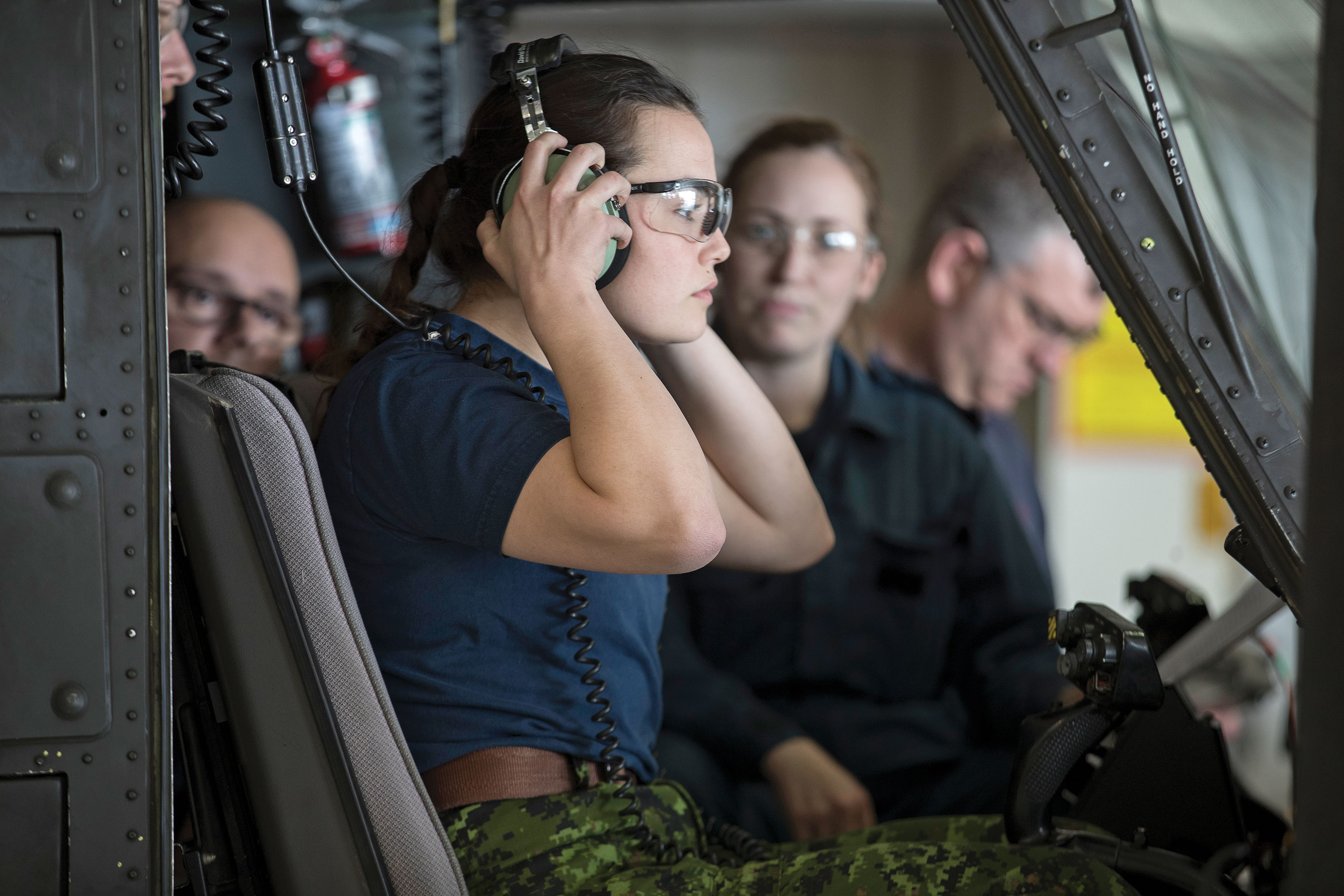
Crew members drift onto the tarmac at around 9:50 a.m., knowing their helicopters are ready for the task ahead. Flight engineers do an external inspection while flight crews go through the communications and startup procedures. Engine start is precisely at 10. It’s a cold start, so warm-up and pre-flight checks take about 20 minutes. The takeoff and first two phases are done in radio silence: takeoff is controlled by lights from the tower: green means go.
The three Griffons lift off at precisely 10:30 and fly toward the Milsom Hill rendezvous, slated for 10:39. Measuring air speed and timing is vital from the outset. At the rendezvous, the Griffons slip into formation, with the mission commander’s chopper in the lead and the others on either side according to where their door gun is mounted. On this mission, fire is reserved for self-defence. The C6 alone will do, because space is needed for passengers.
The Griffons arrive at holding area Quebec precisely on time. The lead chopper—code-named Wolf-11—rises up to get clear communications with the special operations force at the landing zone. Wolf-12 and Wolf-13 circle low, behind the shelter of a large hill.
The order to go is received at 10:56 and the Griffons sweep over the hill and into the extraction site. Wolf-11 flies cover while Wolf-12 leads Wolf-13 to the landing zone. Skids hit the ground at precisely 11:00 and, within a minute, both lift off with the rescuees and fly directly to Petersville, the recovery site. Because they are carrying such a critical package—the president and his entourage—the mantra for this phase is “suppress, bypass and avoid” enemy fire.
Wolf-11, however, has to land last to extract five special ops personnel. It takes fire on the way out, but all three Griffons make it safely to Petersville about 12 minutes later. Mission accomplished.
The president of West Isles was rescued in a carefully planned operation carried out by well-trained personnel operating capable aircraft. For the pilot trainees, the mission is a success. For 403 Squadron, it’s just another day keeping Canada’s workhorse Griffons ready for action.
Historian Marc Milner is honorary colonel of 403 Squadron.
Griffon Upgrades
The Griffon fleet is now more than 20 years old, and it needs to keep flying. Having tactical helicopter capability is “absolutely critical to the success of the full range of military operations,” said Harjit Sajjan, Canada’s Minister of National Defence, in January.
To ensure that, the government announced it will upgrade the helicopter’s avionics, communications and navigation systems. This will extend the life of the Griffon fleet to the early 2030s, and buy time for the RCAF to plan and order its next generation of tactical helicopters.
The original supplier of the CH-146 Griffon, Bell Helicopter Textron Canada, will oversee design and development of the upgrades. Pratt and Whitney will supply new PT6T-9 TwinPac engines, which will deliver a little extra power. Work on the project—valued at some $800 million—is to start around 2022.
Advertisement












